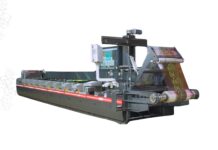Weldon non residue tamper evident label stock
Weldon Cellopast launched their new range of non-residue tamper evident void seurity labelstock at the India Label Show 2006 in December 2006. When removed, labels made from yhis stock do not stain the surface or leave any adhesive residue. The words “void” (which repeat at regular intervals), which are built into the label face-stock, open up and become readable on the label when the label is peeled off from any surface on which it is applied. Thus, the label cannot be reused and shows that the product or package has been tampered with.
”
HELL demonstrates direct laser engraving for flexo sleeves
HELL Gravure Systems demonstrated their new PremiumFlexo system at Proflex 2006 at Stuttgart Media University (HdM) in November 2006. They had also organised an Open House event together with Hueck Folien at the latter’s plant in Weiden, Germany earlier. PremiumFlexo is an exciting new high-end technology for producing very high-quality flexographic forms by direct laser engraving. The technology is primarily designed to engrave seamless flexo sleeves. The sleeves themselves, designated PremiumSleeve, are made from a new-generation elastomer and produce high-resolution forms. The heart of the process is called PremiumSetter; it is a laser engraver for high-resolution direct engraving and is controlled by PremiumRip, which enables each individual screen to be profiled precisely in three dimensions. Tests have been carried out by printing a wide variety of substrates including aluminium foil and polymer films with excellent results. The whole process enables the production of flexo forms using a single-stage operation with all the components (PremiumSleeve, PremiumSetter and PremiumRip) fully integrated with each other.
Sibress E3: New technology for quality control of sleeves and flexoplates
Sibress, a manufacturer based in Brixen, Italy, has introduced a new, small measuring instrument named E3. The E3 System is appropriate for measuring sleeves in all usual dimensions, flexoplates, metal-backed plates, film, and print. The Sibress team developed the new measuring device with an optimum level of ergonomics, automation as well as ease of use in mind.
The Sibress E3 is equipped with a 3.3 megapixel CCD color camera. The completely newly developed and integrated LED illumination enables the user to work also without a light table. To measure sleeves, the instrument uses an optionally available, and specially developed, sleeve adapter ring to measure a field of view of 7 square millimeters. In the case of measuring normal plates or film, the system is equipped with an integrated optical view finder to place the instrument exactly on the region of interest. The fast manual focussing in the live video mode makes the precise measurement even faster.
To connect the Sibress E3 to a notebook or PC the instrument is equipped with a USB-2 connector to supply the required power. Its low weight and the ability to use a USB cable of more than 3 meters make the instrument very flexible to use. Therefore the instrument can deliver results anywhere on your material. The specially developed Versatile@flex software runs under Windows XP and 2000. The automatic and manual modes are easy to handle and individual adjustments are easy to store and retrieve.
Analysis with precision and intelligence
The software Versatile @flex analyzes all newly captured or previously stored images. Dot area %, screen ruling, dot diameter, and many other relevant parameters are analyzed. A fairly automated measuring process enables the user view the result within seconds.
The E3 enables the user to measure highlight and shadow. With sleeves the user is able to measure the critical highlights from 1-10%. Barcode reading can be done as well. The optional strip holder enables the user to measure the flanks of cut flexo plates as well as their thickness.
Versatile@flex offers the possibility to store all images made and can even store the results together with the image. All measured data can be exported to an Excel file for any kind of statistical analysis. All in all, the Sibress E3 instrument is easy to use, attractive, and supplies all the flexibility of control.
GIDUE to talk about new Athena and Xpannd at Label Summit
GIDUE’s new Athena flexo and Xpannd offset at India Label Summit Among the speakers who will participate in the Summit, Federico d’Annunzio, President of GIDUE S.p.A., will be involved in the session of the conference dedicated to the newest technology advances and opportunities. His speech will elucidate how performance and efficiency can be maximized in the label business.
As the Label Summit India visitors will hear and see, this is especially true for the two most recent presses from GIDUE: the flexo sleeve gearless mid-web Athena and the offset Xpannd™ presses. D’Annunzio will introduce the audience to the novelties concerning both printing processes.
The development of not simply a UV offset press, but a new offset technology resulted in a press specifically dedicated to the self-labels and packaging industry. The ink management inside the Xpannd allows high print quality for both fine process and heavy solids thanks to the 16 rollers in the ink train, the over dimensioned rollers, and the innovative fully automated ink management system. High-speed productivity, due to the robust manufacturing and to the redesigned ink train, is also possible without affecting the print quality. The Xpannd offset head is able to achieve good and consistent print quality at the unprecedented speed of 12 m/min. The wasted substrate during set up gets very close to that generated by the Flexo process. The Xpannd offset press is an important and significant result obtained by the combined efforts of GIDUE’s designers and engineers, who redesigned the ink flow geometry inside the ink train.
The new mid-web press Athena has been thought and designed to implement the advantages of in-line presses for the global packaging industry. It features an open structure – for multiple choices of web path, with the insertion of a full range of accessories – flexo/gravure and intelligent controls for web temperature, register, tension, print pressure, UV and drying adjustments. Thanks to its heavy duty and gearless configuration the Athena is able to print and convert from thin film to heavy laminated board, i.e., any web substrate available for packaging.
UV TIME! is the new UV curing process recently introduced in the market by GIDUE in cooperation with Air Liquide, the French leader in the Liquid Gas industry. The heart of the process, thought as answer to the critical issues in the packaging industry, is the prevention of photo-initiators, which are responsible for ink polymerization, from creating unwanted radical combinations with the oxygen particles carried by the web, when excited by UV radiations. The main effect is the elimination of radicals responsible for odours and ink migration, the decrease in the amount of expensive photo-initiators inside UV inks formulations, and the increase in curing speed rates.
UV TIME! has been offered to the market coupled to the latest GIDUE UV flexo press Athena.
UV inks make inroads
The high growth of the print industries in Asia has compelled most of the large ink manufacturers to start manufacturing in the region. Although ink often sells at commodity prices it is not as simple a product as when everything was printed on paper and in black and white. The widespread use of high quality colour on complex substrates at high speeds is making it necessary for South Asian packaging printers and converters to use the latest print technologies including UV inks and curing systems.
For carton manufacture on board, foil and plastics a significant number of 6-colour offset presses have been imported with interstage and end-of-press UV curing. Narrow web flexo label presses have used UV inks and curing for many years in the region. UV inks allow printing on thin flexible substrates at high speeds since the curing is instantaneous. Also since UV inks are transferred and cured in their entirety on the substrate there are no volatile organic compounds (VOCs) escaping into the atmosphere.
Since UV inks maintain their flow properties until they are exposed to UV radiation and cured they also cause less clogging of the cells of the anilox rolls. In fact it is said that the ink can be left on the press overnight without fear of drying since there is no drying by oxidation. However, although using UV inks on narrow web label presses for printing on flexible materials is compelling, several aspects of the technology need to be understood and absorbed.
Fortunately some of the press manufacturers and ink suppliers have been taking this issue seriously with seminars, serious consulting and handholding, and even installing ink kitchens for UV inks and coating at some of the leading consumers.
The challenges when using plastic substrates include that of achieving a good surface tension on the substrate. Plastic films with a very low surface tension are treated to increase the surface tension to 40 dynes/cm or higher. Although some substrate suppliers try and meet this specification, in-line treatment is the best way to ensure that the surface tension is in the acceptable range at the time of printing. Corona discharge treatment (oxidative) is the most common treatment and can be used on numerous types of substrates without damaging heat-sensitive plastics. Gas flame treatment is used on heat tolerant plastics and chemical treatments and primers are also used, often in conjunction with corona treatment. To monitor the surface tension a dyne level test kit is a necessary.
The surface tension of the ink must be lower than the substrate and the surface tensions of coating must be lower than that of the inks for proper wetting and adhesion. In comparison solvent-based inks are quite liquid and have very low surface tension. In addition UV inks must be matched to the substrates since plastics cannot absorb any of the ink and some of the formulations can actually attack the surface and swell the substrate. Other precautions are necessitated by the need to perform subsequent operations such as hot-foil stamping because when the UV inks cure they can form a surface that is denser and harder than conventional inks. Foiling at lower temperature or cold foil stamping is preferable.
The most frequently mentioned issue is that of adhesion. UV inks and coatings are formulated to work with specific types and levels of UV radiation. These affect not only the curing but also the plastic substrate\’s final properties. UV inks or coatings may look cured but may not be cured all the way through the degree of cure near the bottom of the film is critical to achieving good adhesion.












